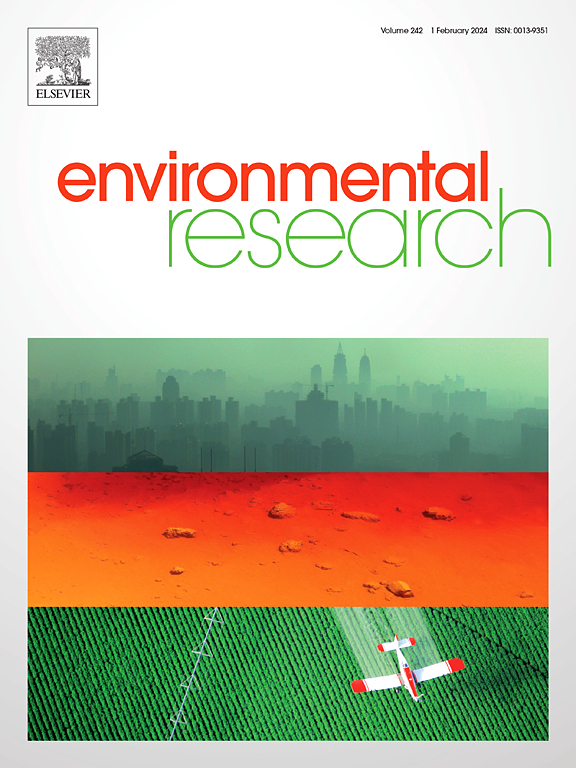Ambient air pollution, urban green space and childhood overweight and obesity: A health impact assessment for Barcelona, Spain
IF 7.7
2区 环境科学与生态学
Q1 ENVIRONMENTAL SCIENCES
引用次数: 0
Abstract
Background
The burden of childhood overweight and obesity attributable to ambient air pollution and a lack of urban green spaces (UGS) remains unknown. This study aimed to estimate the attributable cases of childhood overweight and obesity due to air pollution and insufficient UGS exposure in Barcelona, Spain.
Methods
We applied a quantitative health impact assessment approach. We collected childhood overweight and obesity prevalence levels and exposure data from 69 spatial basic health zones in Barcelona. We estimated particulate matter (PM2.5) and nitrogen dioxide (NO2) levels using land use regression models, normalized difference vegetation index (NDVI) levels using remote sensing and percentage of green area (%GA) using land use. We estimated relative risks, population attributable fractions, and preventable overweight/obesity cases in children under following scenarios: Compliance of World Health Organization (WHO) air quality guidelines (AQGs) for (1) PM2.5 and (2) NO2; achieving (3) city-target NDVI levels and (4) 25% green area (%GA) recommendations. The analyses were stratified by socioeconomic deprivation index (in quintiles). Uncertainty was quantified using Monte Carlos simulations.
Results
Compliance of WHO AQGs could prevent 0.4% [253 (95%CI, −604; 1086)] and 4.2% [3000 (95%CI, 1009; 4943)] of childhood overweight/obesity cases due to excess PM2.5 and NO2 levels in Barcelona, respectively. Compliance of NDVI and %GA targeted levels could prevent 6% [4094 (95%CI, 1698; 6379)] and 10% [6853 (95%CI, 1440; 12779)] of childhood overweight/obesity cases respectively. The preventable burdens of childhood overweight/obesity cases were slightly higher in middle-class socioeconomic areas due to the higher adverse exposure levels at baseline (high air pollution, less UGS).
Discussion
Compliance with WHO AQGs and achieving UGS targets can reduce childhood overweight and obesity levels in Barcelona, and potentially in other locations as well. This underscores the need for policies that foster healthier urban environments of high environmental quality in order to protect child health.
环境空气污染、城市绿地与儿童超重和肥胖症:西班牙巴塞罗那健康影响评估。
背景:环境空气污染和城市绿地(UGS)不足造成的儿童超重和肥胖问题仍不为人知。本研究旨在估算西班牙巴塞罗那因空气污染和城市绿地不足而导致的儿童超重和肥胖病例:我们采用了定量健康影响评估方法。我们从巴塞罗那的 69 个空间基本健康区收集了儿童超重和肥胖患病率水平和暴露数据。我们利用土地利用回归模型估算了颗粒物(PM2.5)和二氧化氮(NO2)水平,利用遥感估算了归一化差异植被指数(NDVI)水平,利用土地利用估算了绿地百分比(%GA)。我们估算了以下情况下的相对风险、人口可归因分数和可预防的儿童超重/肥胖病例:符合世界卫生组织(WHO)关于 (1) PM2.5 和 (2) NO2 的空气质量准则 (AQGs);达到 (3) 城市目标 NDVI 水平和 (4) 25% 的绿地面积 (%GA) 建议。分析按社会经济贫困指数(五分位数)进行分层。利用蒙特卡洛模拟对不确定性进行了量化:遵守世卫组织空气质量准则可分别防止巴塞罗那 0.4% [253 (95%CI, -604; 1086)]和 4.2% [3000 (95%CI, 1009; 4943)]的儿童因 PM2.5 和 NO2 水平超标而超重/肥胖。遵守 NDVI 和 %GA 目标水平可分别预防 6% [4094 (95%CI, 1698; 6379)]和 10% [6853 (95%CI, 1440; 12779)]的儿童超重/肥胖病例。在中产阶级社会经济地区,儿童超重/肥胖病例的可预防负担略高,原因是基线不良暴露水平较高(空气污染严重,UGS较少):讨论:遵守世界卫生组织的空气质量准则和实现 UGS 目标可以降低巴塞罗那以及其他地区的儿童超重和肥胖水平。这突出表明,为了保护儿童健康,有必要制定政策,营造更健康、环境质量更高的城市环境。
本文章由计算机程序翻译,如有差异,请以英文原文为准。
求助全文
约1分钟内获得全文
求助全文
来源期刊

Environmental Research
环境科学-公共卫生、环境卫生与职业卫生
CiteScore
12.60
自引率
8.40%
发文量
2480
审稿时长
4.7 months
期刊介绍:
The Environmental Research journal presents a broad range of interdisciplinary research, focused on addressing worldwide environmental concerns and featuring innovative findings. Our publication strives to explore relevant anthropogenic issues across various environmental sectors, showcasing practical applications in real-life settings.
 求助内容:
求助内容: 应助结果提醒方式:
应助结果提醒方式:


